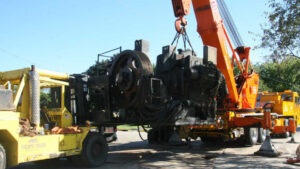Relocating heavy machinery is a complex process that requires strategic planning, specialized equipment, and well-coordinated procedures to ensure a safe and efficient move. One of the most critical components of this process is rigging—a specialized practice that involves lifting, moving, and positioning heavy equipment using a combination of tools such as slings, chains, hooks, and cranes.
Introduction to Rigging in Industrial Relocation
Rigging is a foundational skill in industries that require the movement of large or delicate equipment, including construction, manufacturing, energy, and even museum artifact transport. It encompasses the techniques and equipment used to safely lift and transfer heavy loads. Understanding rigging is essential for anyone involved in machinery relocation, from project managers to field technicians. Familiarity with rigging practices enhances communication on-site, supports safety compliance, and reduces the risk of costly errors or delays.
Planning and Preparation
Successful rigging begins with thorough pre-move planning. This includes assessing the equipment’s dimensions and weight, evaluating the site layout, and identifying potential challenges such as limited access, low ceilings, or uneven ground. Accurate weight calculations are critical to maintaining load stability. Rigging professionals must locate the center of gravity and determine appropriate lifting points to ensure the machinery can withstand stress during transport and hoisting.
Site assessments are also vital. Teams should inspect both the departure and arrival locations for obstructions and structural limitations that may affect the lifting or installation process.
Selecting the Right Rigging Equipment
Choosing appropriate rigging tools is essential to the success of a heavy machinery move. Depending on the machinery’s design and weight distribution, crews may use:
- Slings or chains for lifting
- Spreader bars to evenly distribute weight across multiple lift points
- Cranes or hoists matched to the required lift height and capacity
Environmental conditions such as weather or temperature extremes may also influence equipment selection. Knowledgeable crews will consider these variables when choosing rigging solutions that balance safety, efficiency, and machinery integrity.
The Importance of Load Testing
Before beginning the lift, rigging systems should undergo load testing. This process verifies that slings, hooks, and lifting mechanisms can safely handle the anticipated weight under real-world conditions. Load testing helps identify weaknesses in the setup and is an essential step in adhering to occupational safety standards. Project managers are typically responsible for coordinating these tests and documenting results to ensure regulatory compliance.
Mitigating Safety Risks
Rigging plays a critical role in reducing safety hazards on the job site. Heavy equipment moves often occur in active or confined spaces, making safety a shared responsibility among all personnel. Effective communication is key—rigging teams must operate under the guidance of an experienced supervisor and use established hand signals or radio protocols, especially when visibility or noise is a factor.
Additional safety measures may include:
- Risk assessments
- Jobsite barricades to limit access
- Equipment inspections prior to use
Regular safety briefings and adherence to site-specific guidelines further support a safe working environment.
Value of Experienced Rigging Professionals
Expertise is crucial in rigging operations. Certified riggers possess the training needed to interpret load charts, assess site conditions, and execute complex maneuvers. Their experience allows them to anticipate complications and adapt in real time. Investing in a skilled rigging team improves the efficiency of the move and helps prevent accidents or equipment damage.
Rigging During Transport
Rigging responsibilities do not end once equipment is lifted. During transportation, crews must secure the load to prevent shifting that could lead to damage or road hazards. Tools such as tie-down straps, load binders, and protective coverings are commonly used. Route planning is another important element—crews should collaborate with logistics teams to avoid sharp turns, steep grades, or low-clearance areas.
Final Positioning and Installation
The final stage of relocation is precise placement and installation. Often performed in tight or controlled environments, this phase may require specialized rigging techniques to align machinery to operational requirements. Crews may also level and anchor equipment during installation, working closely with engineers to ensure the machinery is positioned correctly for optimal performance and safety.
Need Professional Help?
If your organization is planning a heavy machinery relocation, it is essential to work with professionals who specialize in industrial rigging. At ARCO, our expert crews provide safe, efficient, and tailored rigging services across the Chicago area. From initial assessment to final placement, we bring technical precision and reliability to every step of the process.
Contact ARCO today to learn more about our rigging solutions and how we can support your next equipment move with confidence and care.


